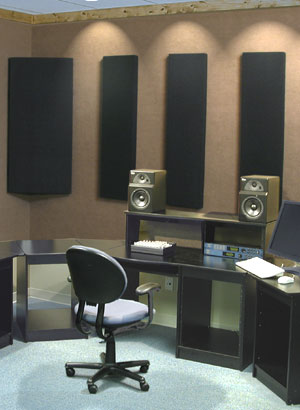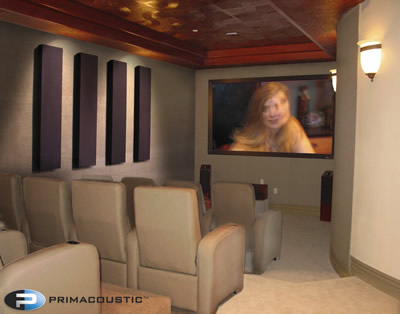|

Primacoustic Panels Tune Your Home TheaterBy Jim Bray Having good audio and video equipment is important if you want the best from your home theater, but having your room right can be vital to ensure all that equipment sounds as good as it can. Most mainstream homes aren't built with good sound in mind. If your home is anything like my "typical suburban home" it features a variety of rectangular rooms that are basically symmetrical in their layout, boxes suitable for furniture but whose walls are very reflective, bouncing sounds all over the place. Neither of my two home theaters are in a room that's up to snuff. The smaller home theater is infected with a side wall made of stone, with a fireplace in it that not only heats up the action during the winter, but which also "fires" reflected sounds most alarmingly. Still, it's more than adequate as a mainstream home theater room for most uses, especially for watching movies, as opposed to listening to music. But I wanted more for the big home theater I built in the basement. I wanted its big screen and big sound to approximate as closely as possible a real recording studio, the type of place where the music and soundtracks are created and mixed. Alas, not only is the room just a big rectangle (professional installations prefer to use non-parallel surfaces and the like to help optimize the sound) but the case for my tensioned 106 screen is large and reflects sounds alarmingly – so much so that it can become shrill when you crank it. Which is nearly every time I fire it up. What to do? Well, my wife is making me a "screen-case condom" to help control its excesses, but the main savior comes from Primacoustic, a Vancouver-area company that manufactures just the type of room deadening materials I needed. They even sell them as whole room solutions, which is the route they suggested I try, via one of their $700 Broadway studio kits. Primacoustic sent me their London 12A Acoustic Room Kit, which they say was developed for "Typical rooms with dimensions that are common in both residential and commercial construction." The kit is supposedly designed for rooms of up to about 120 square feet, whereas my home theater is about twice that size, but it's working out fine anyway. The kit showed up in a huge carton containing everything you need to drag your room into compliance with your audio wishes, except for the screen case condom. The company says it addresses problems with primary reflections, flutter echo, standing waves and excessive bass. One recommended way of setting up the room is in a "LEDE" (live-end, dead-end) configuration where you put most of the dampening at the end of the room where the sound originates (where the main speakers are), leaving the "receive area" more reflective to, as they say, "retain natural room ambiance." And I had thought an ambiance was what you called when you needed a fast trip to the hospital… Anyway, Primacoustic's Broadway kits not only include the acoustic panels to mount in the listening room, but all the hardware and brackets are included as well – and unlike some stuff I've tried to assemble of the years it all works! Even an idiot who's all thumbs can mount the panels, as I proved when I put most of them up by myself (after my best friend helped me with the corner units, and with gauging where to put the panels on the side walls). The panels are made from high density fiberglass the company claims absorb more sound with fewer panels than "typical low cost 1.3 lb. foam alternatives". They're encapsulated with micromesh on front and rear surfaces, with the sides resin hardened "to create sharp looking architectural lines". You won't see most of that when they're on your walls, however; what you will see is a handsome fabric Primacoustic offers in three "esthetically neutral colors". I chose gray (black and beige are the other choices) and the panels look terrific on my walls, giving the room a "serious audiophile" look that'll amaze and impress your friends. You can also put your own breathable fabric on the panels, if none of the three color choices appeal to you.
Where you mount the panels is important, of course, and the company's website at www.primacoustic.com has a lot of background information that can help. We mounted the two 24" by 48" Broadband Panels in the corners opposite to the La-Z-Boy (and the couch on which he sits), as recommended, to help control excessive bass. The kit also comes with eight 12" by 48" "Control Columns" and a dozen, 12 inch square "Scatter Blocks". Primacoustic's web site includes a really cool tip for deciding where to put the panels. It'll require a second person, but all you need to do is have one person sit in the normal listening position while the second one runs a small mirror along the side wall. When the person seated can see a speaker reflected in the mirror, that's where you should put the panel. It's an elegantly simple solution I wouldn't have thought of in a million years and, best of all, it appears to work. One thing I don't want to do is effect adversely the deliberately reflected sounds from my Definitive Technology speakers which, like some people I know, are bipolar. In this case, bipolar means they have identical sets of speaker drivers on both the front and rear surfaces, the idea being to reflect sound from the rear-firing drivers off the wall and back into the room to spread the sound around in a more natural manner. Put simply enough for even me to understand, since higher frequencies are quite directional, the reflective aspect to the bipolar speakers is supposed to give the sound less directionality and, supposedly, make it sound more natural. All of which means there are good reflections and bad reflections, and the Primacoustic treatment is all about managing the bad reflections. As of this writing, I haven't mounted all of the Primacoustic panels yet; I'm still experimenting. Since the acoustic characteristics of my room are changed by the panels, I'm messing around with a variety of configurations and placements, including moving not only some of the panels around but the speakers as well, a bit, and I'm even doing listening sessions with the retractable screen up and down, to see if it has an effect on the overall sound. And, yes, I'm driving my wife nuts. When all is said and done and I've set up the room the way I want it to be, I think there'll be a few Primacoustic panels left over – since my home theater also features book shelves, DVD/Blu-ray shelves and other things that also break up the bad reflections. That means I'll have a few panels to use in my very live-sounding office, to hopefully make it effective as a small studio. In the meantime, the Primacoustic stuff is not only making my "typical suburban home" theater sound more like it should, it also spices up its look very nicely. Copyright 2010 Jim Bray Jim Bray's columns are available through the TechnoFile Syndicate. We welcome your comments! |
|
|||

 Mounting the panels is accomplished by screwing "impalers" onto the wall and then hanging the panels on them. It's very easy and if you've screwed up, you can merely lift the panels off again and remount them. If you've really screwed up (or decide to move, or whatever), you can remove the impalers and then fill the screw holes again, which is undoubtedly a lot better than trying to pry off a panel that's glued on the wall.
Mounting the panels is accomplished by screwing "impalers" onto the wall and then hanging the panels on them. It's very easy and if you've screwed up, you can merely lift the panels off again and remount them. If you've really screwed up (or decide to move, or whatever), you can remove the impalers and then fill the screw holes again, which is undoubtedly a lot better than trying to pry off a panel that's glued on the wall.